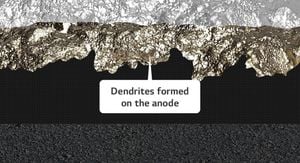The accelerating pace of climate change has amplified the urgency for innovative solutions to reduce atmospheric CO2 levels. Among these solutions, the electrochemical reduction of CO2 (CO2RR) is garnering attention for its potential to convert greenhouse gases directly from the atmosphere to useful products. Recent advancements have spotlighted bismuth (Bi)-based catalysts, particularly due to their efficiency in producing formic acid, which is valued both as a chemical feedstock and potential fuel. Yet, the challenge remains: most commercially available Bi catalysts predominantly feature non-defective, inert sites, limiting their catalytic performance.
A groundbreaking study has introduced the novel approach of utilizing tensile strain to activate these inert Bi sites. By applying rapid thermal shock and mechanical disruption techniques, researchers have crafted what they term Bi-MOF-TS, or bismuth metal-organic framework under tensile strain. This innovative catalyst effectively activates previously inert non-defect Bi sites, leading to remarkable outcomes.
Experimental results show Bi-MOF-TS achieving over 90% Faradaic efficiency over a broad potential range of 800 mV. Impressively, its formate partial current density reaches -995 ± 93 mA cm−2, indicating superior performance compared to traditional catalysts. Notably, under acidic electrolyte conditions, Bi-MOF-TS exhibits formic acid Faradaic efficiency as high as 96 ± 0.64% at 400 mA cm−2.
The environmental significance of this research is grounded not only within laboratory walls but extends to real-world applications, particularly energy-efficient devices such as Zn-CO2 batteries. Utilizing Bi-MOF-TS as the cathode, these batteries demonstrate peak power densities of 21.4 mW cm–2, supporting stable operation over 300 cycles, showcasing the practicality of this innovation.
Background research has identified the necessity to activate inert Bi sites to achieve necessary efficiencies for CO2RR, especially when utilizing acidic electrolytes where CO2 is less prone to react with the medium, thereby enhancing conversion efficiencies. Prior attempts to increase Bi activity through defect integration and heteroatom doping only marginally enhanced performance, leaving many pure Bi sites still relatively ineffective.
The introduction of tensile strain promotes vacancy formation at Bi sites, which has been shown to improve the binding and subsequent reduction of CO2 due to the enhanced adsorption of *OCHO intermediates, leading to lower reaction barriers. By employing density functional theory (DFT), the study elucidates how continuous vacancies generate broader tensile strain effects on surrounding lattice sites, enhancing the performance across multiple sites.
Key insights revealed through high-angle annular dark-field scanning transmission electron microscopy (HAADF-STEM) and other spectroscopic techniques confirmed the formation of tiny Bi clusters around the non-defective sites, effectively increasing the catalyst's overall active surface area. Using these precise imaging techniques allowed the research team to visualize the localized strain effects within Bi-MOF-TS.
Another significant aspect of the study is its focus on the long-term stability and practical application of the catalyst. Both industrial-oriented electrochemical reactors and solid electrolyte systems demonstrated the ability of Bi-MOF-TS to sustain high efficiency during extended operation, affirming its potential as a suitable candidate for commercial CO2 conversion processes.
Researchers noted the significance of the tensile strain-induced vacancies not just for their immediate catalytic activity but also for establishing long-term activity patterns across wide-ranging reaction conditions. This versatility is particularly relevant for the development of sustainable energy technologies aimed at reducing CO2 emissions.
Despite confirming the advantages of Bi-MOF-TS, the study also highlights the need for future research to explore the internal mechanisms behind the strain effects and vacancies, which can shed light on the broader application prospects of Bi-based catalysts.
Overall, this ground-breaking study showcases the adaptability and forward-thinking nature of the modern scientific approach to addressing climate challenges. By activating initially underwhelming inert sites through mechanical and thermal manipulation, scientists have paved the way toward efficient, scalable CO2 reduction technologies conducive to both environmental and economic imperatives.



